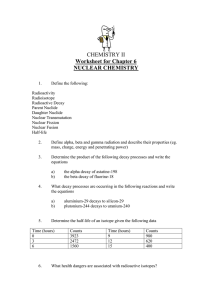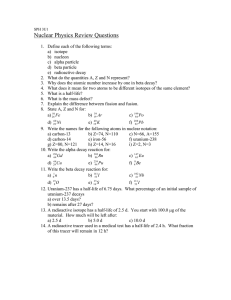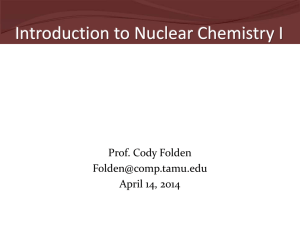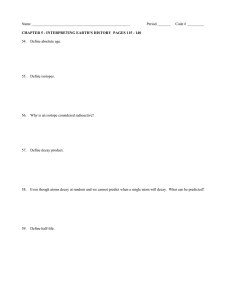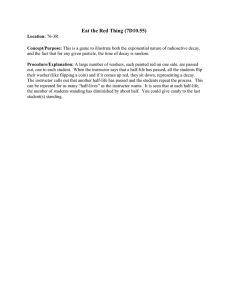Supplementary Application 1: Radioactive Decay
advertisement
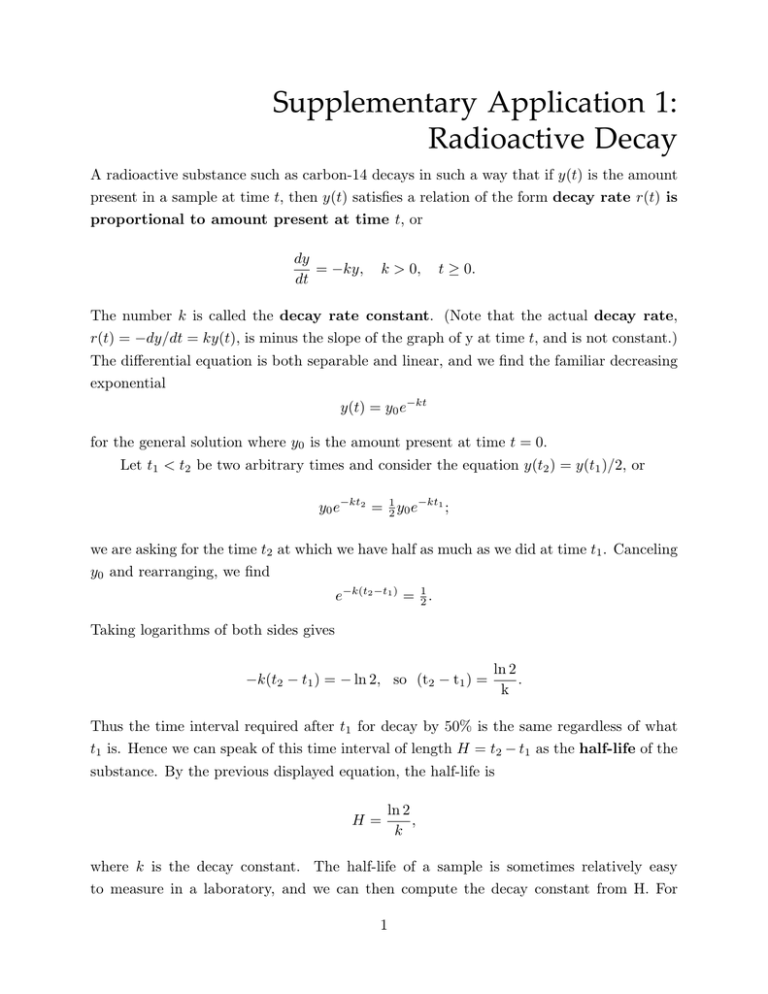
Supplementary Application 1: Radioactive Decay A radioactive substance such as carbon-14 decays in such a way that if y(t) is the amount present in a sample at time t, then y(t) satisfies a relation of the form decay rate r(t) is proportional to amount present at time t, or dy = −ky, dt k > 0, t ≥ 0. The number k is called the decay rate constant. (Note that the actual decay rate, r(t) = −dy/dt = ky(t), is minus the slope of the graph of y at time t, and is not constant.) The differential equation is both separable and linear, and we find the familiar decreasing exponential y(t) = y0 e−kt for the general solution where y0 is the amount present at time t = 0. Let t1 < t2 be two arbitrary times and consider the equation y(t2 ) = y(t1 )/2, or y0 e−kt2 = 12 y0 e−kt1 ; we are asking for the time t2 at which we have half as much as we did at time t1 . Canceling y0 and rearranging, we find e−k(t2 −t1 ) = 12 . Taking logarithms of both sides gives −k(t2 − t1 ) = − ln 2, so (t2 − t1 ) = ln 2 . k Thus the time interval required after t1 for decay by 50% is the same regardless of what t1 is. Hence we can speak of this time interval of length H = t2 − t1 as the half-life of the substance. By the previous displayed equation, the half-life is H= ln 2 , k where k is the decay constant. The half-life of a sample is sometimes relatively easy to measure in a laboratory, and we can then compute the decay constant from H. For 1 2 Supplementary Application 1 example, carbon-14 has a half-life of about H ≈ 5568 years, so its decay constant with time measured in years is ln 2 k= ≈ 1.245 · 10−4 . H The number of atoms of a substance in a typical sample is very large, on the order of 1023 per gram of the substance. However, for some purposes it is more convenient to think of y(t) as a continuous approximation to a number of atoms rather than to a mass; this is so in the next example, in which a decay rate is expressed as a number of atoms per gram per minute. Example 1 Radio-carbon dating In living wood the decay rate of carbon-14 is partly balanced by absorption of additional carbon-14 from the environment; the resulting decay rate for carbon-14 atoms in living wood has been measured empirically to be about 6.68 per minute per gram of wood. When a tree dies, exponential decay of carbon-14 is no longer balanced by growth of the wood, because natural absorption through growth has stopped. If a tree has died at some unknown time in the past that we designate as t = 0, we’d like to estimate the corresponding present time t1 on that scale. Let y(t) be the amount of carbon-14 in a sample at time t, and let r = −dy/dt be its decay rate in atoms per gram per year. From the radioactive decay differential equation we get r(t) = ky(t), where k = 1.245 · 10−4 is the radioactive decay constant of carbon-14. Since we know that ky(0) = 6.68 and y(t) = y(0)e−kt , we must have r(t) = ky(t) = ky(0)e−kt = 6.68e−kt . Solving r(t) = 6.68e−kt for t gives 1 t = − ln k à ! r(t) . 6.68 Suppose we are able to measure the decay rate r(t1 ) = 6.3 in a laboratory. Then the observed rate of decay of 6.3 atoms per gram per minute would give an age, measured from tree-cutting time, of à ! 1 6.3 t1 = − ln ≈ 470 years. 1.245 · 10−4 6.68 Note that starting with half-life measured in years, and hence with years for the time units of k, we were able to change time units for the rates 6.3 and 6.68 to minutes. The reason Radioactive Decay 3 is that both rates could have been measured using years or any other common time unit since we used only their ratio in the final calculation. Example 2 An atom of a radioactive substance typically decays into an atom of some other radioactive substance with its own decay constant. For example, uranium-238, with a half-life of 4.51·109 years and decay constant m = 1.537 · 10−10 , decays to thorium-234 with a half-life of 0.066 years and decay constant n = 10.498; after a sequence of 17 decay steps, the result is the element lead 206. Lead 206 is radioactively stable, and no further decay takes place in this sequence. Some of the longer-lived elements in the uranium series are useful for dating oil paintings that contain lead compounds, and it is important to understand the interplay between two or more elements in the series. We’ll consider the first two named here: uranium-238 and thorium-234. Let U (t) be the amount of uranium-238 in a sample at time t ≥ 0, and let T (t) be the amount of thorium-234 in the same sample. Then dU = −mU. dt Since the amount of thorium present, and hence its rate of change, is enhanced by the rate mU > 0 at which uranium decays to thorium, we have dT = −nT + mU. dt The preceding pair of differential equations is an example of a coupled system of first-order equations. In this example, the system is easy to solve, because the first equation does not contain T ; we solve it and get U (t) = U (0)e−mt . The second equation is then dT = −nT + mU (0)e−mt . dt This is a first-order linear equation, and in normal form it looks like dT + nT = mU (0)e−mt . dt The integrating factor is ent , and the solution is à ! mU (0) −mt mU (0) −nt T (t) = + T (0) − e e . n−m n−m 4 Supplementary Application 1 In this example, m = 1.537 · 10−10 , and is so small that even over the interval 0 < t < 2000 years e−mt decreases only to about 0.999997. For this reason, if n is relatively large, the last term in the expression for T (t) tends to zero fairly rapidly as t gets large. Because e−mt varies so slowly, the first term appears to be practically constant. Thus, instead of tending to zero as we would expect, there seems to be a kind of temporary “equilibrium” value E for T (t) as t increases moderately from zero: E is about mU (0)/(n − m) after 2000 years. Over a long enough time period, T (t) does tend to zero of course. EXERCISES 1. Thallium 206 has a half-life of 4.19 minutes and decays atom-for-atom to lead 206. If we start with 1 gram of thallium 206, how much is left after l minute? How much is left after 1 hour? How much lead 206 will we have after 2 minutes? 2. Suppose that charcoal from an ancient campsite exhibits 0.9 disintegrations per minute per gram of carbon-14 as compared with 6.68 disintegrations for live wood. Estimate the age of the charcoal. 3. Suppose that a sample of charcoal is known, independently of carbon-14 dating, to be 1200 years old. What rate of carbon-14 decay would the sample be expected to exhibit? 4. If a sample of some radioactive element is reduced from 1.0 gram to 0.91 gram after 37 days, what is the half-life of the element? 5. Decay cascade One of the elements in the uranium series is uranium-234 with a halflife of H1 = 2.48 · 105 years. Uranium-234 decays to thorium 230, which has a half-life of H2 = 80, 000 years. Thorium 230 in turn decays to radium 226, which has a half-life of H3 = 1622 years. (a) If we have a sample of pure uranium-234, what fraction will remain after 10,000 years? (b) If we start with 1 gram of pure uranium-234, how much thorium 230 will be present after 10,000 years? (c) If a single sample of radioactive material consists of l gram of uranium-234 and 1 gram of thorium 230, how much of each will be present after 10,000 years? (d) If a single sample of radioactive material consists of 1 gram of uranium-234, how much radium 226 will be present after 10,000 years? 6. Suppose we have an initial quantity U0 of a radioactive element, say uranium, with decay constant m. Suppose the uranium decays to another radioactive element, say thorium, with initial quantity T0 and decay constant n where n > m. Show that if nT0 < mU0 Radioactive Decay 5 then, after time t = 0, the amount of thorium increases to an absolute maximum and then decays toward zero. 7. Branching cascade. Branching sometimes occurs in radioactive decay. For example, bismuth-214 has a half-life of 19.7 minutes, but 99.96% of the atoms decay to polonium-214, with a half-life of 1.64·10−4 second, while the remaining 0.04% decay to thallium-210, with a half-life of 1.32 minutes. The decay of polonium and thallium each results in the same element, lead-210. Let k1 , k2 , k3 represent the decay constants for bismuth, polonium, and thallium, and let p = 0.9996. Derive a formula for the amount of lead 210 present at time t, in terms of k1 , k2 , k3 and p, if we were to start at t = 0 with 1 gram of pure bismuth-214.

